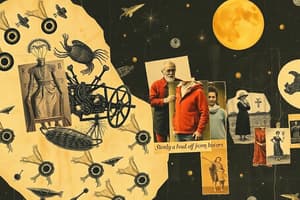Podcast
Questions and Answers
Which statement best describes the Cell Theory?
Which statement best describes the Cell Theory?
- Eukaryotic cells do not contain a nucleus
- Cells are only found in multicellular organisms
- All living things are made up of prokaryotic cells
- All cells come from preexisting cells (correct)
What differentiates prokaryotic cells from eukaryotic cells?
What differentiates prokaryotic cells from eukaryotic cells?
- Eukaryotic cells contain organelles (correct)
- Eukaryotic cells lack a nucleus
- Prokaryotic cells are always multicellular
- Prokaryotic cells are larger in size
What is a defining characteristic of archaea?
What is a defining characteristic of archaea?
- They live in extreme environments (correct)
- They are always unicellular
- They lack a cell wall
- They are similar to plants
Which type of organisms are mostly unicellular and contain organelles?
Which type of organisms are mostly unicellular and contain organelles?
What is the primary function of fungi?
What is the primary function of fungi?
Which kingdom includes both multicellular and unicellular organisms?
Which kingdom includes both multicellular and unicellular organisms?
What distinguishes eukaryotic cells from prokaryotic cells?
What distinguishes eukaryotic cells from prokaryotic cells?
What differentiates bacteria from archaea?
What differentiates bacteria from archaea?
What is the primary means by which plants obtain their food?
What is the primary means by which plants obtain their food?
Which category does not include any unicellular organisms?
Which category does not include any unicellular organisms?
Study Notes
- Characteristics of living organisms: growth and development, reproduction, respond to stimuli, maintain internal conditions (homeostasis), use energy
- Cell Theory: all living things are made up of one or more cells, cells are the basic unit of life, all cells come from preexisting cells
- Cell Theory origin: advancement of microscope technology, collaboration and competition among Western scientists
- Prokaryotic Cells: single-celled organisms, no nucleus, no organelles, enclosed in a cell wall, domain of Bacteria and Archaea
- Eukaryotic Cells: have a nucleus, typically larger and more complex organisms, multicellular, domain includes Protists, Fungi, plants, and animals
- Cell Wall: prokaryotic cells have a cell wall, eukaryotic cells have a cell membrane
- Cell Types: Archaea (unicellular prokaryotes, around 20,000 species), Bacteria (unicellular prokaryotes, around 30,000 species), Protists (unicellular and multicellular, around 100,000 known species), Fungi (mostly multicellular, over 6 million known species), Plants (around 382,000 known species), Animals (over 6 million species, divided into mammals, birds, reptiles, amphibians, and insects)
- Organelles: subcellular structures that have specific jobs in a cell.
Studying That Suits You
Use AI to generate personalized quizzes and flashcards to suit your learning preferences.
Description
Test your knowledge on the characteristics of living things and the history and principles of cell theory. Explore concepts such as organization by cells, growth and development, reproduction, response to stimuli, homeostasis, and the fundamental principles of the cell theory.




